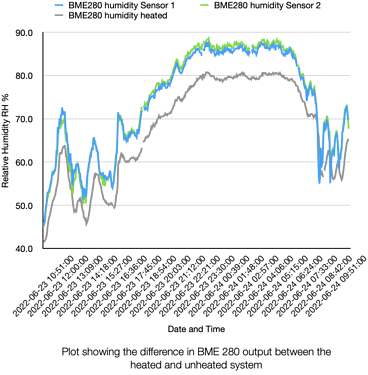Hi
We have have been running two of the Sensor Community’s low cost sensors for about 18 months and during that time they have performed quite well although the BME280s lost their calibration and the fans on the SDS011 became noisy. To reduce the issue with noise we have tightened the screws and secured the systems more tightly to the down pipe they are attached to we have also replaced the old BME280s. These sensor systems are now running smoothly. We have also introduced a third sensor system to the same location; the Nettigo heated smog sensor to see if there is a difference between the heated and unheated systems and we wish to share some of our preliminary results and observations here with the community and would welcome any comments on this post. Our provisional findings from the data are.
-
There is quite a variation between all three sensors. This is more than 5% and leads us to question how to interpret the value from a single sensor.
-
The value from the Nettigo smog sensor SDS011 is significantly lower than the other two SDS011 sensors even at low humidities. Could this be the factory variation in the SDS011s, an ageing effect of the laser diode in the older sensors or an artefact of the Nettigo system? (Note the humidity reading on the BME280 is also lower on the Nettigo system).
-
Normalising the data indicates that the SDS011s perform similarly at humidities below 70%RH . Both the unheated systems perform exactly the same throughout . This suggests a simple calibration factor is all that is needed to provide accurate results below RH of 70%.
-
Beyond 70% RH the heated sensor seems to do well at eliminating the high count unless there is mist or fog.
I give some snap shot examples below where sensor 1 and sensor 2 are the unheated systems clearly more data is required, but this pattern of sensor output seems to be repeatable.
Here there is a clear difference in the BME280 output
Here the heated system seems to show a relatively flat profile suggesting that the increases on sensor 1 and 2 are all due to the rise in humidity.
Here the effectiveness of the heated system is not so clear cut with the possibility of an increase also appearing on the heated sensor at high humidity.
Normalising by the average values below 70%RH for each sensor gives the following plot which shows good agreement of the unheated sensors and agreement with the heated system below 70% RH (as expected)
We will continue to analyse the data and gain more information from them but thought we would share these early results for comment.



